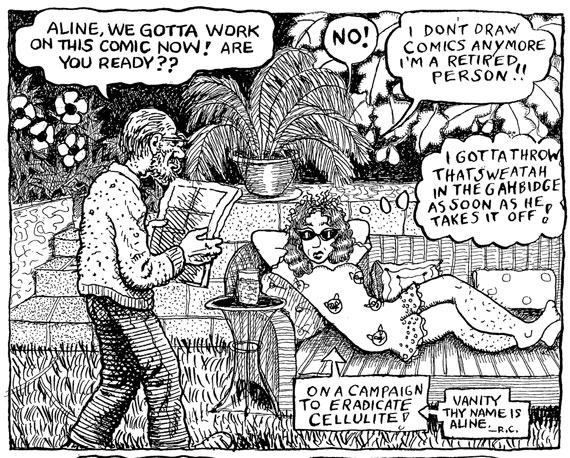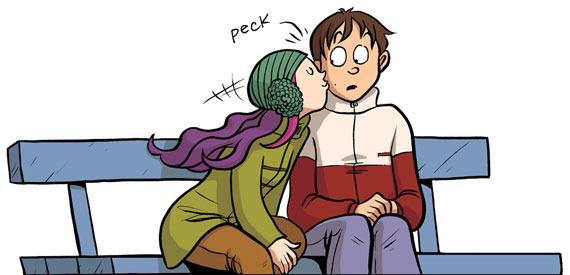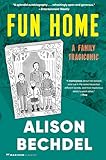
1.
“Comics Not Just For Kids Anymore, Reports 85,000th Mainstream News Story,” The Onion announced on July 10, 2012. There’s truth there, but only so much. Critics in The New York Times Book Review, Slate, NPR and The New Yorker now appraise individual comics without questioning the value of the medium as a whole. The cliché still appears in outlets whose editors should know better, but it’s unlikely The Onion could tell the same joke in another 10 years.
The best way to kill a debate is to avoid acknowledging it and comics artists are as guilty as anyone else of prolonging the argument. In 2004, I attended a talk by Art Spiegelman on his September 11 book. He explained his layout methods in detail. It was a good discussion. He also kept defending the right of comics artists to sit at the adults’ table. That was irritating. In 2006, Houghton Mifflin added comics to its Best American series list. Alison Bechdel, the guest editor of the 2011 edition, was ambivalent about working in a “newly legitimized art form.” The problem is generational. Younger comics writers and artists tend not to defend the seriousness of their vocation. If they inhabit the margins of culture, they know there’s nothing intrinsic to the medium that places them there.

 Scott McCloud, the guest editor of the 2014 edition of Best American Comics, — the series editor is now Bill Kartalopoulos — is famous for improving the debate. In the early ’90s, McCloud wrote Understanding Comics, a comic book about comic books that explained how the medium reinvents time and space and imagines realities that can’t be adapted to other media. Reinventing Comics, which was published in 2000, was a prescient analysis of how the Internet and the digital world would affect comics readers and creators. He can be as defensive as Spiegelman, but he’s also a smarter interpreter. Like the earliest political philosophers, McCloud points out the obvious and makes it sound profound only because no one before him wrote the obvious down.
Scott McCloud, the guest editor of the 2014 edition of Best American Comics, — the series editor is now Bill Kartalopoulos — is famous for improving the debate. In the early ’90s, McCloud wrote Understanding Comics, a comic book about comic books that explained how the medium reinvents time and space and imagines realities that can’t be adapted to other media. Reinventing Comics, which was published in 2000, was a prescient analysis of how the Internet and the digital world would affect comics readers and creators. He can be as defensive as Spiegelman, but he’s also a smarter interpreter. Like the earliest political philosophers, McCloud points out the obvious and makes it sound profound only because no one before him wrote the obvious down.
The Best American Comics 2014 reads as a sequel to McCloud’s theoretical studies. Previous guest editors instructed readers to thumb through the anthologies and choose work that interests them most just as they would browse the shelves in a comics shop. McCloud asks that you read his anthology in order, cover-to-cover, and that you treat it as a critical narrative. He divides his book into discrete sections, presenting a taxonomy of genres. The book is an argument on the state of comics in the second decade of the 21th century.
2.
What makes a great comic great? McCloud summarizes the criteria:
Is the story built around quiet everyday events or autobiography? Check. Does it have a dark satiric undercurrent? Check. Does our protagonist have a low opinion of him/herself? Check. Is there a complete absence of anything that might remotely remind you of a superhero comic? Check.
 He’s being facetious, but the gatekeepers, those who honor what Ted Rall once told me was “the Fantagraphics crowd,” seem to always honor comics that follow at least one of these criteria. Many of the comics McCloud selected from an enormous pile Kartalopoulos gave him follow at least one of the first three and pretty much all of them follow the fourth. (McCloud wanted but was unable to include Matt Fraction’s Hawkeye comics.)
He’s being facetious, but the gatekeepers, those who honor what Ted Rall once told me was “the Fantagraphics crowd,” seem to always honor comics that follow at least one of these criteria. Many of the comics McCloud selected from an enormous pile Kartalopoulos gave him follow at least one of the first three and pretty much all of them follow the fourth. (McCloud wanted but was unable to include Matt Fraction’s Hawkeye comics.)
“Great Comics” are not the same as “Great Fiction” or “Great Non-Fiction.” Any New York Times critic would have savaged the sentimentality in Craig Thompson’s Blankets if it came packaged in a prose novel. Bechdel needs her images to sell her wit; in a comic the famous “Bechdel Test” is astute, but the average male reader would roll his eyes if he first encountered her theory in one of the online essays it spawned. A great comic does not have to be sentimental nor simple, but sentimentality and simplicity are not problems for comics.
 “High Road to the Shmuck Seat” by Aline Kominsky-Crumb and Robert Crumb from Best American Comics 2014 edited by Bill Kartalopoulos. Originally appeared in Viewotron #2. Copyright (c) 2013. Used by permission of Houghton Mifflin Harcourt Publishing Company. All rights reserved.
“High Road to the Shmuck Seat” by Aline Kominsky-Crumb and Robert Crumb from Best American Comics 2014 edited by Bill Kartalopoulos. Originally appeared in Viewotron #2. Copyright (c) 2013. Used by permission of Houghton Mifflin Harcourt Publishing Company. All rights reserved.
 That much is obvious in the opening section of McCloud’s anthology, dedicated to the recent work of old masters. In “High Road to the Schmuck Seat,” R. Crumb portrays himself as a happily married aging pervert and not as a raging Mickey Sabbath. His grotesque line drawing, which he’s used throughout his career to express an unrelenting sexual anxiety, now obscures a sweet loving heart. In Charles Burns’s The Hive, teenagers bond over anatomical drawings. Burns’s cleanly-drawn entrails sit comfortably next to his old-before-their-time adolescents. It’s a touching scene. Call it dark sentimentality.
That much is obvious in the opening section of McCloud’s anthology, dedicated to the recent work of old masters. In “High Road to the Schmuck Seat,” R. Crumb portrays himself as a happily married aging pervert and not as a raging Mickey Sabbath. His grotesque line drawing, which he’s used throughout his career to express an unrelenting sexual anxiety, now obscures a sweet loving heart. In Charles Burns’s The Hive, teenagers bond over anatomical drawings. Burns’s cleanly-drawn entrails sit comfortably next to his old-before-their-time adolescents. It’s a touching scene. Call it dark sentimentality.
 “Drama” (excerpt) by Raina Telgemeier from Best American Comics 2014 edited by Bill Kartalopoulos. Originally appeared in Drama. Copyright (c) 2012. Used by permission of Houghton Mifflin Harcourt Publishing Company. All rights reserved.
“Drama” (excerpt) by Raina Telgemeier from Best American Comics 2014 edited by Bill Kartalopoulos. Originally appeared in Drama. Copyright (c) 2012. Used by permission of Houghton Mifflin Harcourt Publishing Company. All rights reserved.


 “Dark sentimentality.” I put the phrase in a Google search and out came a list of indie rock reviews. Take from that what you will, but it’s the dominant mood in the anthology and it bleeds from one comic to the next and one section to the next, from adventure comics to family memoirs. “Raising Readers,” a section dedicated to children’s comics, contains excerpts from two devastating depictions of childhood loneliness, Raina Telgemeier’s Drama and Fanny Britt and Isabelle Arsenault’s Jane, the Fox and Me. The excerpt from Drama ends with a full-page panel of an empty playground. A small-scale strip from Chris Ware’s Building Stories, which McCloud names as the best book of the year, serves as a grim counterpoint with its depiction of a mother discovering the pain of solitude as her child grows older and more independent. Ware and Raina Telgemeier understand the eerie power of bold block colors and negative space. They make clichés sublime. They make small emotions huge.
“Dark sentimentality.” I put the phrase in a Google search and out came a list of indie rock reviews. Take from that what you will, but it’s the dominant mood in the anthology and it bleeds from one comic to the next and one section to the next, from adventure comics to family memoirs. “Raising Readers,” a section dedicated to children’s comics, contains excerpts from two devastating depictions of childhood loneliness, Raina Telgemeier’s Drama and Fanny Britt and Isabelle Arsenault’s Jane, the Fox and Me. The excerpt from Drama ends with a full-page panel of an empty playground. A small-scale strip from Chris Ware’s Building Stories, which McCloud names as the best book of the year, serves as a grim counterpoint with its depiction of a mother discovering the pain of solitude as her child grows older and more independent. Ware and Raina Telgemeier understand the eerie power of bold block colors and negative space. They make clichés sublime. They make small emotions huge.
 Hip Hop Family Tree” (excerpt) by Ed Piskor from Best American Comics 2014 edited by Bill Kartalopoulos. Originally appeared in Hip Hop Family Tree. Copyright (c) 2013. Used by permission of Houghton Mifflin Harcourt Publishing Company. All rights reserved.
Hip Hop Family Tree” (excerpt) by Ed Piskor from Best American Comics 2014 edited by Bill Kartalopoulos. Originally appeared in Hip Hop Family Tree. Copyright (c) 2013. Used by permission of Houghton Mifflin Harcourt Publishing Company. All rights reserved.

 You may not have to adjust your mood from one comic to the next or one section to the next, but you do have to adjust your eye. The “Testimonials” section includes excerpts from two histories of American music, Frank M. Young and David Lasky’s wonderful The Carter Family: Don’t Forget This Song and Ed Piskor’s Hip Hop Family Tree. Both books are infused with melancholic nostalgia in as much as modern country and hip hop no longer express the joy of emerging subcultures. They are staid institutions. And Lasky and Piskor explore that nostalgia by employing the grammar of vintage comics. Lasky borrows from early 20th-century comics strips. His stars achieve iconic status thanks to his careful, simple lines. The panels follow a clear linear trajectory, like the steady beat of a country song. Hip Hop Family Tree is a campy re-rendering of a 1980s de-saturated comic. The motive for each comic is the same, but like the subjects they depict, they belong to separate realms.
You may not have to adjust your mood from one comic to the next or one section to the next, but you do have to adjust your eye. The “Testimonials” section includes excerpts from two histories of American music, Frank M. Young and David Lasky’s wonderful The Carter Family: Don’t Forget This Song and Ed Piskor’s Hip Hop Family Tree. Both books are infused with melancholic nostalgia in as much as modern country and hip hop no longer express the joy of emerging subcultures. They are staid institutions. And Lasky and Piskor explore that nostalgia by employing the grammar of vintage comics. Lasky borrows from early 20th-century comics strips. His stars achieve iconic status thanks to his careful, simple lines. The panels follow a clear linear trajectory, like the steady beat of a country song. Hip Hop Family Tree is a campy re-rendering of a 1980s de-saturated comic. The motive for each comic is the same, but like the subjects they depict, they belong to separate realms.
McCloud asks his readers to notice the ways the comics in his anthology talk to each other. They do talk to each other, but they spend more time talking to themselves. With the exception of the work of Gilbert and Jaime Hernandez, not a single character from one comic here could find a home in another. Everyone owns the particularities of their sadness.
3.

 In Reinventing Comics, McCloud admitted that no one has written the War and Peace of comics. In the 14 years since, we may have come closer with Fun Home and Julio’s Day. The Japanese may have come even closer, but the truth is comics, at least American comics, don’t need a Tolstoy any more than country music or hip hop needs a Beethoven.
In Reinventing Comics, McCloud admitted that no one has written the War and Peace of comics. In the 14 years since, we may have come closer with Fun Home and Julio’s Day. The Japanese may have come even closer, but the truth is comics, at least American comics, don’t need a Tolstoy any more than country music or hip hop needs a Beethoven.
Allie Brosh’s Hyperbole and a Half, the most widely read comic in this collection, could only have come from someone robbed of worldly ambitions. Her crudely-drawn webcomic describes the wreckage of mental illness, outwardly describing exactly how a depressive feels herself and the world around her. Her style is primitive and humorous and according to McCloud “rewire[s] a million ideas of what ‘good’ comics look like.” She’s writing postcards from the abyss and she’s giving her audience fleeting moments of comfort. And that should be enough. Question: Why does “Great Non-Fiction” about depression produce a William Styron, but “great” comics about depression produce an Allie Brosh? Why do we accept dark sentimentality from our comics but not from our novels?
The modern novel is made up of words printed in a uniform font, but the comic is made up of drawings, clearly the work of another human being, the closest thing our culture still has to handwritten letters. Reading a comic, like reading a novel, is a private experience, but the texture of the thin paper of a comic is far more powerful than that of the pages of a novel, thanks to the presence of the communicator’s human hand. Even a computer drawing that you read on a laptop is connected to an organic body, in the sense that you can acknowledge the presence of a human hand on a mouse or a digital pen. When you read a comic, you are accepting a direct message from one singular honest soul. Your hand touches theirs. That soul can be strange. That soul can be sick. And it can also be oh-so earnest…
The comic book emancipates adults from irony.









